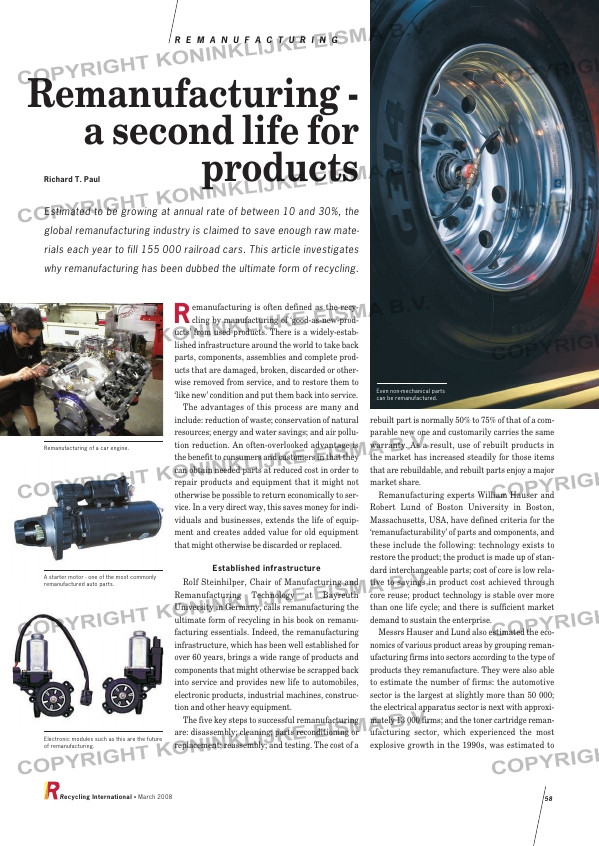Page 58 from: March 2008

R emanufacturing is often defined as the recy-cling by manufacturing of ‘good-as-new-prod-
ucts’ from used products. There is a widely-estab-
lished infrastructure around the world to take back
parts, components, assemblies and complete prod-
ucts that are damaged, broken, discarded or other-
wise removed from service, and to restore them to
‘like new’ condition and put them back into service.
The advantages of this process are many and
include: reduction of waste; conservation of natural
resources; energy and water savings; and air pollu-
tion reduction. An often-overlooked advantage is
the benefit to consumers and customers in that they
can obtain needed parts at reduced cost in order to
repair products and equipment that it might not
otherwise be possible to return economically to ser-
vice. In a very direct way, this saves money for indi-
viduals and businesses, extends the life of equip-
ment and creates added value for old equipment
that might otherwise be discarded or replaced.
Established infrastructure
Rolf Steinhilper, Chair of Manufacturing and
Remanufacturing Technology at Bayreuth
University in Germany, calls remanufacturing the
ultimate form of recycling in his book on remanu-
facturing essentials. Indeed, the remanufacturing
infrastructure, which has been well established for
over 60 years, brings a wide range of products and
components that might otherwise be scrapped back
into service and provides new life to automobiles,
electronic products, industrial machines, construc-
tion and other heavy equipment.
The five key steps to successful remanufacturing
are: disassembly; cleaning; parts reconditioning or
replacement; reassembly; and testing. The cost of a
rebuilt part is normally 50% to 75% of that of a com-
parable new one and customarily carries the same
warranty. As a result, use of rebuilt products in
the market has increased steadily for those items
that are rebuildable, and rebuilt parts enjoy a major
market share.
Remanufacturing experts William Hauser and
Robert Lund of Boston University in Boston,
Massachusetts, USA, have defined criteria for the
‘remanufacturability’ of parts and components, and
these include the following: technology exists to
restore the product; the product is made up of stan-
dard interchangeable parts; cost of core is low rela-
tive to savings in product cost achieved through
core reuse; product technology is stable over more
than one life cycle; and there is sufficient market
demand to sustain the enterprise.
Messrs Hauser and Lund also estimated the eco-
nomics of various product areas by grouping reman-
ufacturing firms into sectors according to the type of
products they remanufacture. They were also able
to estimate the number of firms: the automotive
sector is the largest at slightly more than 50 000;
the electrical apparatus sector is next with approxi-
mately 13 000 firms; and the toner cartridge reman-
ufacturing sector, which experienced the most
explosive growth in the 1990s, was estimated to
Recycling International • March 2008 58
R E M A N U F A C T U R I N G
Estimated to be growing at annual rate of between 10 and 30%, the
global remanufacturing industry is claimed to save enough raw mate-
rials each year to fill 155 000 railroad cars. This article investigates
why remanufacturing has been dubbed the ultimate form of recycling.
Remanufacturing –
a second life for
products
Remanufacturing of a car engine.
Even non-mechanical parts
can be remanufactured.
A starter motor – one of the most commonly
remanufactured auto parts.
Electronic modules such as this are the future
of remanufacturing.
Richard T. Paul
RI_020 Remanufacturing:Opmaak 1 28-02-2008 11:46 Pagina 58



